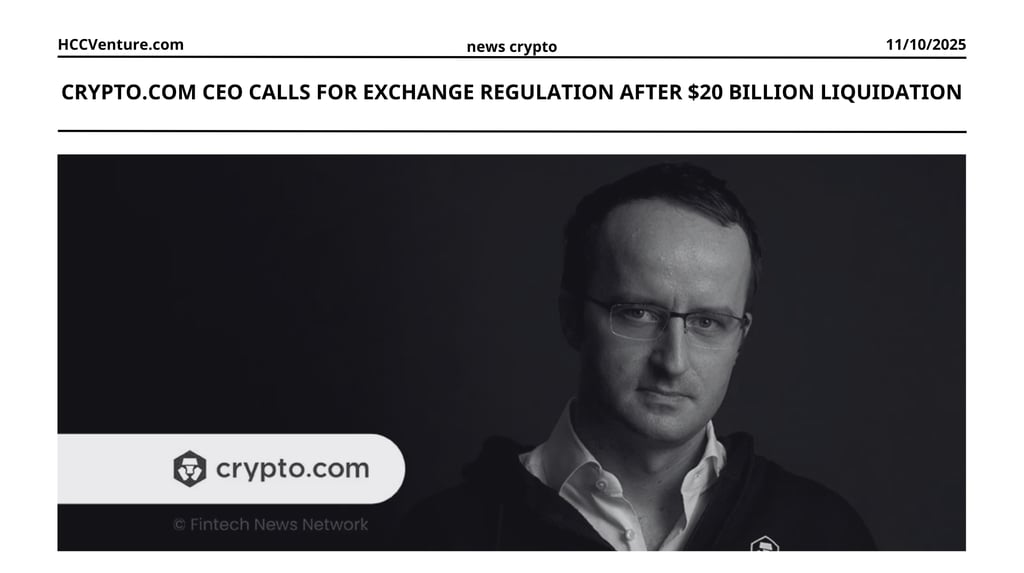Crypto.com CEO calls for investigation into exchanges after $20 billion liquidation
Kris Marszalek has called on global regulators to launch a full investigation into the exchanges that handle the largest trading volumes. Hyperliquid alone accounted for $19.35 billion in forced closures.
10/13/20253 min read


The collapse or the conspiracy behind it
Friday’s crash, which took place between 21:00 and 23:00 UTC, was a perfect storm of macro shocks: Trump’s tariffs on China triggered a wave of risk-off, pushing BTC below $114,000 and ETH to $4,100—a 5% crash in just a few minutes. CoinGlass tallied a total of $19.156 billion in liquidations, with buy orders squashed at $16.7 billion (87% of the total loss) and sell orders at just $2.456 billion, highlighting the dangers of overextended bull traps. More than 1.6 million traders were hit with margin calls, including 6,300 wallets on Hyperliquid alone, where positions evaporated in ADL chains in under a second.
Futures platforms, where leverage reached 100x, amplified the bloodbath. As one post-event analysis put it, “Leverage, tariffs, or both?”—a toxic mix that exposed fragile liquidity in after-hours trading. Binance, the king of trading volume, reported just one liquidation per second—a fraction of the frenzy—while smaller exchanges were pressured by the surge in traffic.
CEO Statement
In a post shared on X and industry media, Marszalek emphasized that despite the inherent volatility of the crypto market, unregulated leverage and opaque liquidation mechanisms have created systemic vulnerabilities that pose a danger to both individual and institutional investors.
“ It is time for coordinated regulatory oversight of exchanges prone to unusually large liquidations. These mechanisms need to be transparent, auditable, and standardized across jurisdictions, ” — Kris Marszalek, CEO, Crypto.com
He also warned that “unsupervised liquidation systems can create artificial selling pressure,” accelerating price collapses and damaging market integrity.
Kris Marszalek's speech on Saturday cleared things up: "Regulators should look at the exchanges with the most liquidations in the past 24 hours and conduct a thorough assessment of the fairness of the operations." Attaching an infographic that clearly ranks platforms by the number of liquidations, he focused on the $19.35 billion outlier Hyperliquid, asking: Was there any "slowdown to the point of stopping, essentially not allowing people to trade"? Were prices "accurate and consistent with the index"? What about "AML and transaction monitoring programs" or "internal trading teams that are completely blocked by China"?
Systemic flaws turned a market crash into a game of retail roulette, with “many users affected.” By contrast, it boasts of “field-tested” resilience, handling spikes without a hitch—a not-so-subtle display amid its own $50 million trading volume. Marszalek’s call for “regulators’ duty…to protect consumers and ensure market integrity,” echoing FTX’s call for transparency in a sector where 70% of trading volume is leveraged.
Transparency from Crypto.com
Crypto.com has previously taken clear steps to reassure users of its financial health. The company has made its Proof-of-Reserves (PoR) data public, shared cold wallet addresses, and even hired third-party auditors to verify asset guaranty. These initiatives, which came after the 2022 crash that saw FTX and other exchanges collapse, are aimed at proving that user deposits are fully collateralized and accessible.
However, while these efforts help Crypto.com differentiate itself from less transparent competitors, critics point out that the audits are not updated regularly and do not fully account for liabilities or off-chain risks — a limitation that raises many doubts.
The timing of Marszalek’s comments is significant. As liquidation volumes hit record highs, many have questioned whether some exchanges are amplifying volatility through opaque liquidation tools or internal market-making arrangements.
Crypto.com, by contrast, has sought to brand itself as a responsible alternative—a platform that advocates auditability, fair liquidation systems, and user accountability. However, even it is not without its criticism: the lack of real-time, continuous proof of reserves, combined with the need for more frequent public audits, means that even regulated exchanges find it difficult to maintain absolute transparency in a 24/7 market.
Explore HCCVenture group
HCCVenture © 2023. All rights reserved.


Connect with us
Popular content
Contact to us
E-mail : holdcoincventure_contact@hccventure.com
Register : https://linktr.ee/holdcoincventure
Disclaimer: The information on this website is for informational purposes only and should not be considered investment advice. We are not responsible for any risks or losses arising from investment decisions based on the content here.


TERMS AND CONDITIONS • CUSTOMER PROTECTION POLICY
ANALYTICAL AND NEWS CONTENT IS COMPILED AND PROVIDED BY EXPERTS IN THE FIELD OF DIGITAL FINANCE AND BLOCKCHAIN BELONGING TO HCCVENTURE ORGANIZATION, INCLUDING OWNERSHIP OF THE CONTENT.
RESPONSIBLE FOR MANAGING ALL CONTENT AND ANALYSIS: HCCVENTURE FOUNDER - TRUONG MINH HUY
Read warnings about scams and phishing emails — REPORT A PROBLEM WITH OUR SITE.
